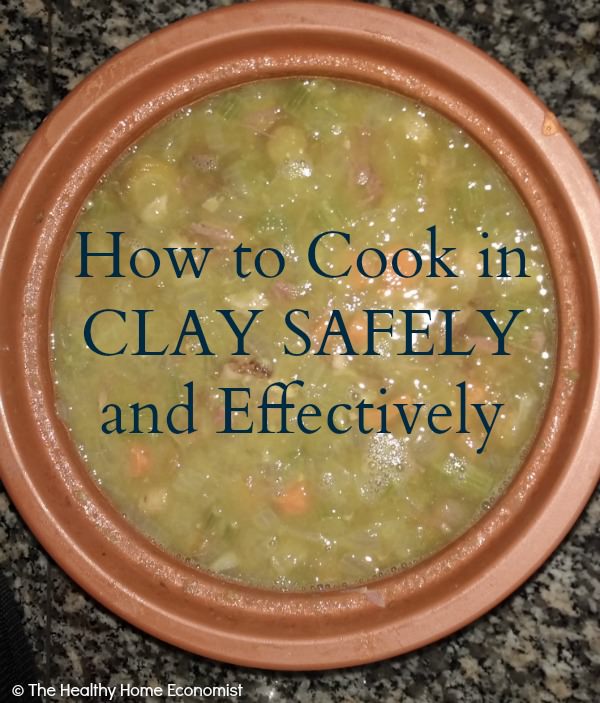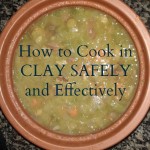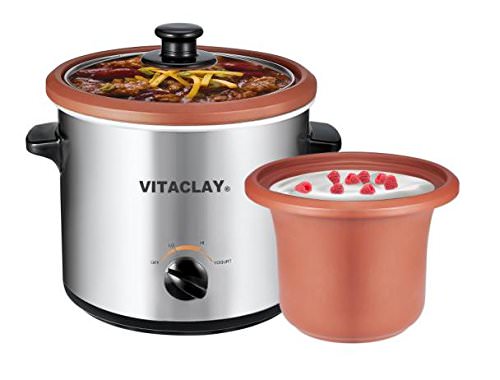Table of Contents[Hide][Show]

Believe it or not, I have only very recently discovered the convenience and, yes, joy, of slow cooking in my home.
I incorporated this very traditional method of food preparation using clay pots which I have found to be quicker (and safer) than using a crockpot, Instapot, or stainless cookware.
While the concept of speedy slow cooking may seem to be an oxymoron, it really isn’t when it comes to clay pots. Let me explain …
My oldest child goes off to college very soon. The reality of him subsisting on unhealthy, highly processed college food after being raised on an organic, whole food diet for his entire life has been weighing on my mind for some time. As a result, I’ve been in search of an easy to use appliance in which he can quickly and safely prepare simple meals for himself as needed.
Clay Pot Cooker vs Instapot
A crockpot might seem like the perfect solution at first. However, I’ve never been thrilled with this option for several reasons (no offense to those of you who love them!). First, most models are made with Teflon, aluminum, and other unsafe materials. Even the few stainless steel models pose the problem of leaching heavy metals like carcinogenic nickel into your food when you cook acidic dishes such as tomatoes (1).
Old-time cast iron slow cookers aren’t necessarily better. These can contribute to the little known health issue of excess iron in the diet. Doctors call it iron overload disorder. This is of particular concern for adult males and menopausal women and recognized as a risk by science.
From a practical perspective, crockpots don’t cook fast enough for me let alone a busy college student.
Safety Issues
I’ve also avoided the fast cooking Instapot or other types of pressure cookers. I am not convinced that this unnatural way to cook food quickly doesn’t in fact greatly increase glutamates (MSG) in the food. This is especially risky when you make bone broth or tomato-based dishes. Pressure cookers are mostly made with stainless steel. This type of material introduces the very real risk of leaching toxic nickel when cooking acidic foods. I prefer an appliance I can use in all cooking situations!
Flavor Comparison
Finally, while crockpots do produce moist, juicy results, I haven’t been overly impressed with the flavor of the crockpot or Instapot meals. They taste bland and maybe a bit overly boiled to my palate. Of course, adding a lot of seasonings covers this up. The most nutritious food tastes amazing with little seasoning, however.
Hence my laid-back attitude toward slow cooking and pressure cookers until I discovered an affordable appliance that combines modern technology and convenience with the benefits and safety of traditional clay cooking. This appliance which I literally cannot live without after using for 2 years is called the Vita-Clay.
Clay Pots 101
Cooking in terra cotta clay pots is an ancient tradition that dates back to the Etruscan civilization that existed around 800 BC. Today, this area in central Italy that includes the city of Florence is known as Tuscany. I was fortunate to be able to visit Tuscany in the Fall of 2015. This travel experience made research into the subject of even greater personal interest.
Clay is a Porous Material
Cooking in clay pots is different than cooking in other materials such as ceramic or stainless steel. The primary difference is the porous clay. No enamel or glaze means the hard-baked clay “breathes”. Thus, water is absorbed and then released during cooking to achieve moist, intensely flavorful results with little to no seasonings. Slow, steady evaporation of steam from within the clay pot’s unglazed pores and the double-sealed lid is what makes this possible.
Cookbook author and Chef Suzanne Vandyck describes the process as follows:
… the clay cooker cooks with a minimum of liquid and retains all the intense flavors of every ingredient, achieved by simmering in its own juices. More of the essential nutrients and vitamins are retained in foods cooked in clay pots because food cooks in a closed environment with limited liquids.
Improved Cooking Efficiency Without Damaging the Food
In addition to intensely flavorful food, the moist clay combined with the double lid design of the model I use, the 8 cup Vita-Clay, creates a micropressure environment that allows for much-improved cooking efficiency. This means you save electricity and time. In fact, clay pot cooking can have your meal ready in up to half the time compared with using other slow cookers.
Speedy slow cooking using clay pots was not the only thing that got me excited about Vita-Clay. You can set the meal to cook and when it is ready, use the delay function to keep it warm until you’re ready to eat. In addition, clay pot cooking is not just suitable for stews. These appliances also cook rice, oatmeal, bone broth, and soups. They even make yogurt!
Vita-Clay Sizes
Below is a picture of the compact, personal Vita-Clay model I am going to send off to college with my son. Would you believe it costs less than $50? And, if the clay pot chips or breaks for whatever reason, it can be easily replaced without buying a whole new cooker. Clay pots are very resistant to damage, by the way, so the chances of this happening are low.
Update: I’ve now used Vita-Clay for two years. I have all three sizes depending on what type/size meal I need to cook. No chips or breaks yet. These pots are very durable!
Cleaning Clay Pots
How about cleaning the clay pots? No dishwasher is necessary although you can use one if you like. Note that dishwashers might discolor the clay pot slightly or cause some lime buildup. To clean, all I do is rinse it out first. Use a drop or two of mild dish soap if desired and a soft dishwashing brush. Then, rinse and wipe clean.
If there are some cooked on bits of food, I soak for an hour or so in plain water in the kitchen sink. Then, dump the water and wipe clean. For tougher to remove food bits, soak overnight using 1 cup water, 1/4 cup white vinegar, and 1 tablespoon baking soda. Rinse and wipe the following morning. I’ve actually never had to use this approach. Little to no scrubbing is necessary in my experience even when I cook rice.
What About Toxins
One of the very first questions I asked before considering cooking in a clay pot was: would it be safe and toxin-free for my family? The clay pot I use made by Vita-Clay is manufactured using organic Zisha clay. Zisha is extremely pure clay, tested to be free from contaminants. This special clay was formed over thousands of years by rainfalls that scrubbed the mountains in southern, nonindustrialized China. These rainfalls released minerals into pristine lakes forming huge clay beds.
This article on lab tests for lead in clay pots provides credible insights for those seeking toxin-free cooking using Vita-Clay.
Most risk of lead contamination comes from glazed, ceramic dishes and pots. The Zisha clay pots are unglazed and have been certified by an independent third-party lab as lead-free (test results here).
They meet the FDA, CA 65, and UL safety requirements. No chemical treatments are applied to the clay during manufacturing.
Making Soup in a Clay Pot
The dishes I love making in the clay pot cooker are soups, stews, soaked rice, soaked oatmeal (soak and cook in one step!) and yogurt. Yes, you can easily make yogurt (using any type of milk: dairy, coconut, almond) in the Vita-Clay!
For now, let me share with you my favorite soup recipe in the Vita-Clay. Just throw in all the ingredients, turn it on and you are done. This is a very easy option for dinner on nights when the schedule is challenging and hectic.

Clay Pot Split Pea Soup Recipe
Easy recipe for split pea soup made in a slow cooker clay pot.
Ingredients
- 2 cups dried split peas
- 5 cups bone broth
- 1 1 lb/.5 kilo ham hock
- 1 pinch turmeric powder
- 1 onion finely chopped, preferably organic
- 4 celery stalks chopped, preferably organic
- 5 carrots chopped, preferably organic
Instructions
-
Put all ingredients in the clay pot right after lunch around 1pm and close the lid.
-
Turn on the “stew” setting for 3-4 hours. Dinner will be ready around 5pm. If you wish to eat dinner at a later time, the Vita-Clay will automatically keep things warm until then.
Recipe Notes
In a pinch, filtered water or a mixture of bone broth and water can be used.
If you buy instead of make bone broth, only buy bone broth packaged in glass jars. Other brands have toxic packaging issues.
Soaking Split Peas First
I like to soak split peas before cooking to increase digestibility and nutrient availability. To do this, put the split peas in a glass bowl with a teaspoon or so of sea salt, cover with filtered water and stir. I do this right after breakfast. You can also do it before you go to bed the night before if that’s easier. Then, after lunch, I drain off the water and put the soaked split peas and remaining ingredients in the Vita-Clay. Gently simmer into a hearty soup and dinner is done by 4-5 pm! Bonus: the Vita-Clay settings keep the meal warm until you are ready to eat.
Using a Vita-Clay Video Demonstration
The brief video below shows me using a Vita-Clay to make dinner. See how easy it is?
Want to Try Cooking in Clay for Yourself?
If this article has you excited to try cooking in clay pots too, note that there are several models to choose from. Click here to check out all the sizes and models available. Use coupon code WISE25 to order what you like best at 10% off. You won’t believe how reasonable the prices are!
Have you already tried cooking in clay pots? If so, what is your experience and what are your favorite dishes to create?
Disclosure: I was NOT paid to write this post although I was provided a Vita-Clay in order to personally verify all product claims. I wrote this article because I am a big fan of the Vita-Clay since researching about the benefits of clay pot cooking and cooking with it constantly over the past five years. Some of the links in this post are affiliate links. I truly believe in what this company is doing to produce a safe, quality product for the public.









I am looking to buy a VitaClay! I want to use it to make bone broths, soups, stews, roasts and whole chickens! Sarah, which one would you get for my first one to use for making those things. Thank you in advance and I appreciate all you do and have been following you for years!
It really depends … here’s my review of both and the pros and cons of each choice compared with the other. Hope this helps! https://www.thehealthyhomeeconomist.com/vitaclay-review/
Hi Sarah,
I love the idea of using the Vita-Clay for soups and such, but what do you use as a replacement for a pan (frying eggs and such)? I want to get rid of my non-stick aluminum pans and I was looking into cast iron, but read your article on the concerns of using them. Do you have any recommendations on what to use?
Also, is Pampered Chef stoneware a safe way to bake things in the oven?
Thank you and have a wonderful Thanksgiving!
No, I do no use the Vita-Clay as a replacement for a frying pan. Enameled cast iron is fine .. just don’t get a plain cast iron pan.
Hi Sarah, have you used the stoneware model? what are the pluses and minuses between the stoneware and the clay?
Will be doing a post comparing the two very soon.
I’m looking for cookware that’s toxin-free. I was going to purchase the VitaClay but noticed that the pot had measurement markings. When I had contacted the company they said the measurement markings were not engraved. They actually use food grade ink. How can VitaClay be a toxin-free option then? Whether the ink is food grade or not, it’s toxic and will leach toxins into the food that’s being cooked.
Only the larger pot has measurement markings, the standard models do not. They are also only at the very top, so if you are concerned, you can leave the liquid below the line. In the years I’ve used one, the markings have never been a problem. They don’t flake off or chip or even fade … I don’t consider this issue to be a concern at all. There is no safer pot on the market that I’ve seen and I look at all of them!
HI Sarah, Your site is my “go-to” site now for all my cooking and health needs. Thank you!! I now have a two Vitaclays and want to try your split pea recipe. QUESTION! Do I need (or want to) soak the split peas to reduce lectin in the peas? Thanks in advance – I hope you answer my question.
Unlike phytic acid, lectins are deactivated with simple cooking. So, no you do not have to soak them unless you want to take that extra step.
Sarah, this article was really interesting, and I was very excited to investigate VitaClay. And, then I read reviews about the company and the product on Amazon. While you may be one of the lucky people to have purchased a reliable unit, there are lots of unhappy customers who’ve experienced real problems with VitaClay. The fact that only 56% of people gave the product a 5 star review is telling (I find that people usually tend to dole out 5 star reviews too freely.) There are numerous complaints about the pots breaking despite meticulous care, some who find the units to be cheaply made, but most troubling for me are the reports of inconsistent heating, and the inability to cook at a really low temperature. After the initial boil, I want to be sure my broth won’t cook at anything above a low, low simmer, ever – it makes the broth bitter and kills the gel. I’ll check back with the company at a later date – maybe they’ll tighten up their quality control and I’ll give them a try. The concept sounds great.
I own 3 of them (all sizes) and have NEVER had a problem. You must consider that some of these reviews may be astroturfed by competing slow cooker/pressure cooker companies.
I am in the market for a new slow cooker. I am going to be making my first batches of chicken broth (including using the feet!) and rendering tallow. Would this be good for rendering? How long do you cook the bone broth in this cooker. I called and they said only 4 hours. Also I saw you mentioned cooking tomato sauces in this. I am used to slow simmering my sauce (sometimes with meatballs) for 10 hours on the stove top, how much would my cooking time change with this? How much broth would I add to the 6 qt for tomato/meatball sauces? So many questions.
I simmer my chicken broth for 18 hours in my large Vita-Clay.
Fantastic! I am excited to explore getting one of these. Sarah what do you use on the stovetop when you do cook with tomatoes or other acidic foods or bone broth?
I use my large Vita-Clay to make soups with homemade bone broth and I use my small Vita-Clay to make tomato based sauces 🙂 I don’t cook anything acidic in stainless steel even though my SS pots are high grade stainless.
Can you make homemade baby food in this thing? Steam it? I don’t want to steam in plastic, obviously, have used stainless and bamboo but the bamboo is not very efficient and the stianless…its ok. This clay pot slow cooker thingy steams?
Yes, steam does gently come out the top while it slow cooks.
The clay pot had been accidently broken, is there any new one can be bought to replace ? I am so sorry that my little grand-daughter may miss her healthy dish…????
Yes, you can buy replacement pots if you check the website.